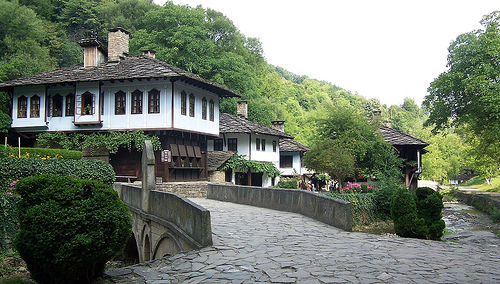

Location: 8 km (6 mi) South of Gabrovo Map
The Etar Architectural-Ethnographic Complex, commonly known as Etar or Etara (Bulgarian: Етър or Етъра), is Bulgaria's first open-air ethnographic museum, dedicated to preserving and showcasing the architecture, customs, culture, craftsmanship, and economy of the Gabrovo region during the Bulgarian National Revival period (late 18th to 19th centuries). Spanning 7 hectares, it functions as a living museum where visitors can witness traditional Bulgarian life through authentic reconstructions, live demonstrations of crafts, and interactive experiences. Founded in 1964, it incorporates historical elements like water-powered machinery and Revival-era buildings, making it a unique cultural landmark that blends education, heritage preservation, and tourism. Often described as a "time capsule" or "living village," Etar attracts families, history enthusiasts, and international tourists, emphasizing Bulgaria's rich ethnographic heritage.
Etar is situated 8 km south of the city of Gabrovo in northern Bulgaria, on the northern edge of the Bulgarka Nature Park, nestled in the foothills of the Balkan Mountains (Stara Planina). Its geographic coordinates are approximately 42°48′34″N 25°20′54″E, overlooking the Sivek River (also known as Yantra River tributary), which powers many of its installations. The site is accessible by car (about 1-2 hours from Sofia or Veliko Tarnovo), bus from Gabrovo, or taxi, with parking available on-site (around 3 leva or free along nearby roads if arriving early). Surrounded by lush forests and natural scenery, the location enhances its immersive, village-like atmosphere, though the terrain involves uneven paths and stairs, making it moderately challenging for those with mobility issues. It's part of a broader tourist route including nearby attractions like the Sokolski Monastery (several km away) and the House of Humor and Satire in Gabrovo.
The concept for Etar emerged in the early 1960s as part of efforts to preserve Bulgaria's ethnographic heritage amid rapid modernization. Construction began in 1963 under the direction of architect Lazar Donkov, incorporating the existing Karadzheyka water mill (built around 1780) as a foundational element. The museum officially opened on September 7, 1964, and was declared a national park in 1967 and a cultural monument in 1971. It draws from the Bulgarian National Revival era, a period of cultural and economic awakening under Ottoman rule, when Gabrovo became a hub for craftsmanship and trade. The site's development involved relocating and reconstructing authentic buildings and machinery from surrounding villages, reflecting a broader movement in Eastern Europe to create open-air museums. During the communist era, it served educational purposes, promoting folk traditions. Post-1989, it evolved into a tourist attraction, with ongoing preservation efforts. Historical ties include legends of local artisans and the region's role in Bulgaria's independence struggles, though no prehistoric or ancient sites are directly linked.
Etar's design recreates a 19th-century Bulgarian village, with
structures built or reconstructed using traditional methods and
materials like stone, wood, and river pebbles. The complex covers 7
hectares and includes over 50 objects, divided into thematic areas. Key
features include:
Water Facilities and Installations: A unique
collection of 10 active water-powered mechanisms along the Sivek River,
such as mills for grinding flour, fulling wool, and woodworking. The
Karadzheyka water mill (circa 1780) is the oldest, fully reconstructed
with original gears and stones.
Craftsman Street: A recreated urban
street from the 19th century with two-story Revival houses featuring bay
windows, wooden balconies, and whitewashed walls. Notable is the Saakov
House with 21 windows, a clock tower, and workshops for various trades.
Workshops and Houses: Over 20 artisan workshops demonstrating crafts
like wood carving, pottery, coppersmithing, furriery, cutlery making,
needlework, and icon painting. Many are housed in authentic relocated
buildings, with interiors furnished with period tools and artifacts.
Other Structures: A school and church building, bridges, fountains, and
residential homes showcasing daily life. The architecture emphasizes
Renaissance influences with ornate facades and functional designs
adapted to the hilly terrain.
Construction took about 12 years,
blending authentic relocations with replicas to ensure historical
accuracy. The river's integration provides natural power, making Etar
one of Europe's few museums with operational hydraulic technology.
Etar has primarily served as an educational and cultural hub,
illustrating Revival-era life through live craft demonstrations using
original tools and methods. Visitors can observe or participate in
activities like baking, weaving, and metalworking, purchasing handmade
souvenirs. It has hosted international initiatives, national contests,
and thematic tours. Key events include:
Opening (1964): Marked
the establishment as Bulgaria's first open-air museum.
Symposiums and
Festivals: Events like the "KEVIS" land art and kinetic art symposium
(e.g., 2020 edition), folk festivals, and craft fairs.
Diplomatic and
Cultural Visits: Notable visits, such as by the Georgian Embassy in
2021, fostering collaborations.
Renovations and Modern Programs:
Post-2020 updates enhanced interactivity, with educational programs for
schools and creative workshops.
During its history, it has been
used for filming, photography, and as a venue for preserving intangible
heritage like folklore and cuisine.
As of August 2025, Etar remains a thriving open-air museum, open daily year-round: 9 a.m. to 7 p.m. in summer (April–September) and 9 a.m. to 5 p.m. in winter (October–April), with no days off. Admission is affordable at about 5 leva (€2.50), and it attracts visitors for 1-3 hour visits, extendable for families. Recent renovations (noted in 2024-2025 reviews) have improved facilities, making it more interactive and well-maintained, though some critiques mention limited English-speaking staff and fewer live demonstrations than expected. It offers on-site eateries serving traditional Bulgarian dishes like banitsa, kachamak, sarma, and sweets at low prices, plus souvenir shops. Educational programs, thematic tours, and events continue, with collaborations for exhibitions. Rated 4.5/5 on platforms like Tripadvisor based on 261+ reviews, it's praised for its authenticity and family-friendliness but noted as smaller than similar European sites. Accessibility includes paths but involves stairs; contact via +359 66 810 560 or info@etar.bg for details. Social media highlights its scenic beauty and cultural value, with no major changes reported in 2025.